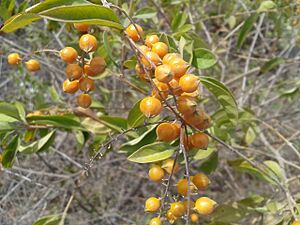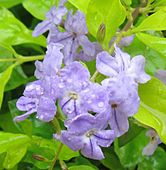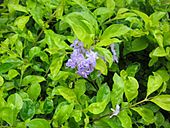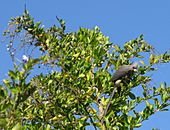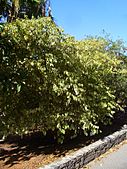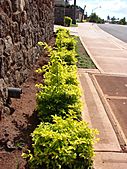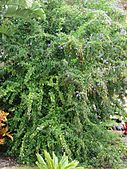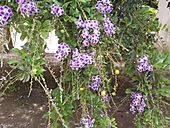Golden dewdrop facts for kids
Quick facts for kids Golden dewdrop |
|
|---|---|
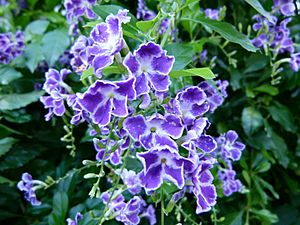 |
|
| Conservation status | |
| Scientific classification | |
| Genus: |
Duranta
|
| Species: |
erecta
|
| Synonyms | |
|
Duranta repens L. |
|
Duranta erecta is a beautiful flowering shrub that belongs to the verbena family, called Verbenaceae. It originally comes from places like Mexico, South America, and the Caribbean. People all over the world grow it in warm, sunny gardens because it's so pretty. You might hear it called golden dewdrop, pigeon berry, or skyflower. It has even started growing on its own in many new places.
Contents
What Does the Golden Dewdrop Look Like?
The golden dewdrop is usually a spreading shrub, but sometimes it can grow into a small tree. It can reach about 6 meters (20 feet) tall and spread just as wide. Older plants often have sharp thorns where the leaves meet the stem. Younger plants usually don't have these thorns.
The leaves are light green and shaped like an oval. They grow in pairs opposite each other on the stem. Each leaf can be up to 7.5 cm (3 inches) long.
Flowers and Fruit
The flowers are a lovely light-blue or lavender color. They grow in tight groups at the ends of stems and branches. These flowers often hang down and bloom during the summer.
After the flowers, small, round, yellow or orange berries appear. Each berry is about 11 mm (0.4 inches) wide and holds several seeds inside.
Naming the Duranta Plant
The name Duranta honors Castore Durante, an Italian botanist from the 15th century. The second part of its scientific name, erecta, means "upright" in Latin. This describes how the plant grows.
Sometimes, you might also see it called D. repens. This name comes from the Latin word for "creeping." It was first used for types of the plant that had smaller leaves.
Where Does Duranta Grow Naturally?
Duranta erecta is native to the Americas. It grows from Mexico and the Caribbean all the way south to Brazil and Argentina. There's a bit of a discussion about whether it's also native to the southern United States, like Florida and Texas. Or if it was brought there by people.
In its natural home, this plant often grows in rocky or sandy areas near the coast. It likes full sun. It can also be found in wetter, disturbed places further inland. Before it's fully grown, the plant can grow about half a meter (1.6 feet) each year.
Growing Golden Dewdrop in Gardens
Golden dewdrop is a very popular ornamental plant in warm tropical and subtropical areas. Its bright flowers and colorful fruit make it a great choice for gardens. The blossoms also attract beautiful butterflies and hummingbirds.
There are many different types of golden dewdrop that people grow. Some popular ones include 'Alba', 'Aurea', 'Gold Mound', and 'Sapphire Showers'.
Is Duranta an Invasive Plant?
In some places, like Australia, South Asia, and Hawaii, Duranta erecta has become an invasive species. This means it grows so well that it can take over and harm local plants. However, in other places where it has been introduced, it has not caused problems.
Important Information About Duranta
It's important to know that the leaves and unripe berries of the golden dewdrop plant are toxic. They can be harmful to animals like dogs and cats if eaten. However, some songbirds can eat the fruit without any problems.
While there are not many clear cases of people getting sick from this plant, it's always best to be safe. Children should never eat any part of the plant. If someone accidentally eats parts of the plant, it's important to get medical help right away.
Scientists have found special compounds in the plant. These include substances called repenins, which are a type of antioxidant. The fruit also contains other compounds like alkaloids. The leaves and fruits contain a substance called saponin glycoside and a small amount of hydrocyanic acid. Some of these compounds can be harmful to insects.
Gallery
-
Mousebird feeding on fruit
See also
 In Spanish: Duranta erecta para niños
In Spanish: Duranta erecta para niños




